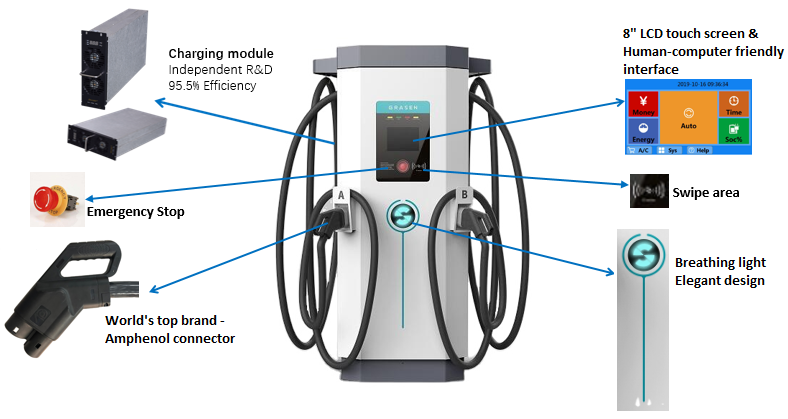For charging station operators, there are two most troublesome issues: the failure rate of charging piles and complaints about noise nuisance.
The failure rate of charging piles directly affects the profitability of the site. For a 120kW charging pile, a loss of nearly $60 in service fees will be caused if it is down for one day due to a failure. If the site fails frequently, it will affect the charging experience of customers, which will bring immeasurable brand loss to the operator.
Currently the charging piles popular in the industry use air-cooled heat dissipation modules. They use a high-speed fan to exhaust the air powerfully. The air is sucked in from the front panel and discharged from the rear of the module, thereby taking away the heat from the radiator and heating components. However, the air will be mixed with dust, salt mist and moisture, and will be adsorbed on the surface of the internal components of the module, while flammable and explosive gases will be in contact with conductive components. Internal dust accumulation will lead to poor system insulation, poor heat dissipation, low charging efficiency, and shorten the equipment lifespan. In the rainy season or humidity, the accumulated dust will become moldy after absorbing water, corrode components, and short circuit will lead to module failure.
To lower the failure rate and fix the noise problems of existing charging systems, the best way is to use liquid-cooling charging modules and systems. In response to the pain points of charging operation, MIDA Power has launched the liquid cooling charging module and the liquid cooling charging solution.
The core of the liquid-cooling charging system is the liquid-cooling charging module. The liquid-cooling charging system uses a water pump to drive the coolant to circulate between the inside of the liquid-cooling charging module and the external radiator to take away the heat from the module. The heat dissipates. The charging module and the heat-generating devices inside the system exchange heat with the radiator through the coolant, completely isolated from the external environment, and there is no contact with dust, moisture, salt spray, and flammable and explosive gases. Therefore, the reliability of the liquid-cooling charging system is much higher than that of the traditional air-cooling charging system. At the same time, the liquid-cooling charging module does not have a cooling fan, and the cooling liquid is driven by a water pump to dissipate heat. The module itself has zero noise, and the system uses a large-volume low-frequency fan with low noise. It can be seen that the liquid-cooling charging system can perfectly solve the problems of low reliability and high noise of the traditional charging system.
The liquid-cooling charging modules UR100040-LQ and UR100060-LQ exhibited adopt a hydropower split design, which is convenient for system design and maintenance. The water inlet and outlet terminals adopt quick-plug connectors, which can be directly plugged and pulled without leakage when the module is replaced.
MIDA Power liquid cooling module has the following advantages:
High protection level
Traditional air-cooling charging piles generally have an IP54 design, and the failure rate remains high in application scenarios such as dusty construction sites, high-temperature, high-humidity, and high-salt fog seasides, etc. The liquid-cooling charging system can easily achieve an IP65 design to meet various applications in harsh scenarios.
Low noise
The liquid-cooling charging module can achieve zero noise, and the liquid-cooling charging system can adopt a variety of thermal management technologies, such as refrigerant heat exchange and water-cooling air-conditioning to dissipate heat, with good heat dissipation and low noise.
Great heat dissipation
The heat dissipation effect of the liquid-cooling module is much better than that of the traditional air-cooling module, and the internal key components are about 10°C lower than the air-cooling module. Low temperature energy conversion leads to higher efficiency, and the lifespan of electronic components is longer. At the same time, efficient heat dissipation can increase the power density of the module and be applied to a higher power charging module.
Easy maintenance
The traditional air-cooling charging system needs to regularly clean or replace the filter of the pile body, regularly remove dust from the pile body fan, remove dust from the module fan, replace the module fan or clean the dust inside the module. Depending on different application scenarios, maintenance is required 6 to 12 times a year, and the labor cost is high. The liquid-cooling charging system only needs to regularly check the coolant and clean the radiator dust, which greatly simplifies
Post time: Nov-10-2023

 Portable EV Charger
Portable EV Charger Home EV Wallbox
Home EV Wallbox DC Charger Station
DC Charger Station EV Charging Module
EV Charging Module NACS&CCS1&CCS2
NACS&CCS1&CCS2 EV Accessories
EV Accessories

